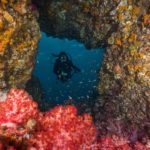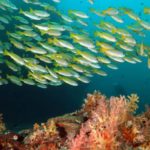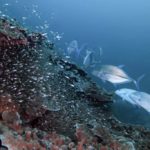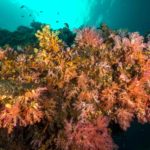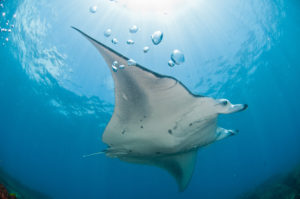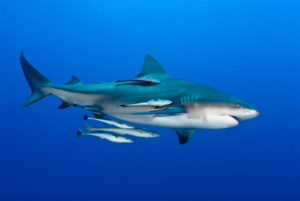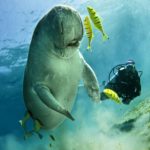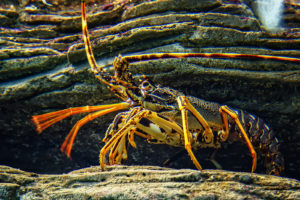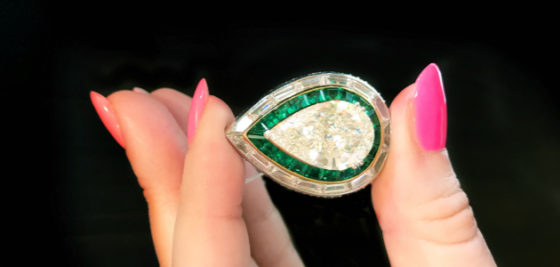The National Marine Sanctuary System spans more than 600,000 square miles of marine and Great Lakes waters. This sanctuary system stretches from Massachusetts to American Samoa. It also offers plentiful unique dive sites, including coral reefs, kelp forests, shipwrecks and more. So, whether you’re thinking about taking the plunge for the first time or have been diving for years, these 10 dives in national marine sanctuaries should be on your national marine sanctuaries diving bucket list.
Cathedrals of of Lānaʻi, Hawaiian Islands Humpback Whale National Marine Sanctuary
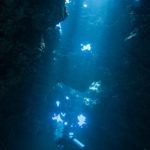
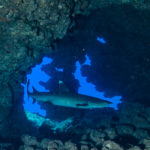
The Cathedrals of Lānaʻi are unlike anything most divers have ever seen. Here, a unique formation of cooled molten lava tubes, caverns, ridges, and passageways create a cathedral effect and an unforgettable experience. The collapsed portions of ceiling structures inside the caverns give the cathedrals their name. Swim through archways and lava structures and watch marine life play hide-and-seek in the caverns. You’re exploring some of the greatest biodiversity Hawaii has to offer. Located within the protective waters of Hawaiian Islands Humpback Whale National Marine Sanctuary, large animals like turtles, manta rays, and sharks, often appear in the area. During peak whale season, if you’re lucky, you may even get to hear a humpback whale serenade.
Middle Reef at Point Lobos, Monterey Bay National Marine Sanctuary
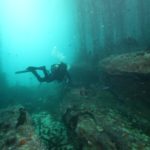
Located within Monterey Bay National Marine Sanctuary and Point Lobos State Natural Reserve, this dive site boasts one of the most spectacular displays of ecosystem health and diversity. This shore dive begins at a boat launch in Whaler’s Cove, offering a short swim before your descent to a sandy channel. At the shallow start, divers often glimpse playful harbor seals or otters — make sure to give them plenty of space. Large schools of blue rockfish are common as well. As the dive continues, the waters gradually deepen and the habitat turns to kelp forest. Look carefully as you explore: bottom-dwelling creatures adorn rock faces and inhabit nearly every crevice. More-experienced divers can venture into even deeper waters where structures and formations get larger. However you plan your dive, make sure to reserve in advance. Daily access to these protected waters is limited to keep them pristine for years to come.
Hidden Reef, Channel Islands National Marine Sanctuary
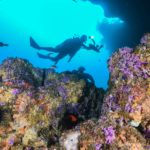
For the adventurous, a hidden treasure awaits in the waters of Channel Islands National Marine Sanctuary. The excitement begins with an overnight charter across dark waters. As sunrise breaks, Santa Barbara Island appears, a tiny spit of land about 38 miles off the California coast. Here, year-round cold temperatures, as well as the current and swell can be problematic for beginner divers. It is best to dive Hidden Reef in the morning when conditions are usually calm.
Underwater near Arch Rock, divers can explore a 30-foot-wide sponge and Corynactis-encrusted archway that lies in about 35 feet (11 m) of water. A crevice near the top of the arch is full of California spiny lobster. Divers passing through the rock structure swim through a maze of kelp to reach Hidden Reef. A drop-off at 60 feet (18 m) reveals rock formations that provide sanctuary for lobsters, swell sharks, lingcod, rock scallops, and purple hydrocorals, adding to the wonder of the Hidden Reef.
Coral Spawn, Flower Garden Banks National Marine Sanctuary
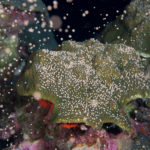
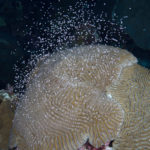
Every year after the full moons of late summer, the reef-building corals of Flower Garden Banks National Marine Sanctuary host a fantastic spawning display. Due to the high density of coral species, the sanctuary is the site of one of the most abundant coral spawning displays in the Caribbean. When the moment is right, coral colonies simultaneously release their gametes into the water to reproduce, creating an amazing experience for divers. This display occurs at roughly the same time each year and scientists are able to predict this ritual using the lunar cycles.
Dives are long and shallow and occur at night. A dive light beautifully highlights the spawning. Tiny, colorful spheres begin to rise from the center of each coral, making the reef look like an underwater snowstorm. As if this weren’t incredible enough, the spawning event attracts many fish and marine life who are in tune with this cycle too.
Garden Eel Cove, Hawaiian Islands Humpback Whale National Marine Sanctuary
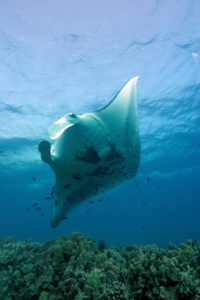
Garden Eel Cove off the Island of Hawaii has been dubbed Manta Heaven – and for good reason. Divers travel by boat to this location to watch a beautiful Hawaiian sunset. As darkness falls, divers descend to the sandy bottom at about 35 feet (11 m) to gather around a “campfire” of stationary lights placed in a circle. As the divers settle in and the sunlight dims, the campfire blazes to life to illuminate the waters above. Tiny plankton swarm to the light source, attracting the highlight of the show: manta rays. From the darkness glide massive rays with wing spans from five to 16 feet (1.5 to 5 m). Attracted by the light and the plankton snack, these gentle giants circle overhead in a glorious ballet.
The Valley of the Giants, National Marine Sanctuary of American Samoa
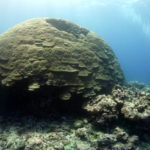
With all the excitement of seeing giants and without the risk of getting trampled by enormous feet, the “Valley of the Giants” is a secret worth sharing. Located in National Marine Sanctuary of American Samoa, the waters surrounding Ta’u Island boast some of the world’s oldest and largest coral colonies. The star attraction is the gigantic Porites coral head called “Big Momma,” or “Fale Bommie.”
Big Momma lies at a depth of 50 feet (15 m), stands two stories tall and four stories wide, and has a girth the equivalent of half a soccer field. More than 500 years old, Big Momma continues to grow each year and provides habitat for fish, invertebrates, and other marine creatures. A territory of the United States, American Samoa lies about 1,600 miles (2,575 km) northeast of New Zealand and 2,200 miles (3,540 km) southwest of Hawaii. Divers should bring their own gear and rent air tanks on the island. Because of its remoteness, divers must charter a vessel to get to this dive site, which is 70 miles away from Pago Pago.
Snapper Ledge, Florida Keys National Marine Sanctuary
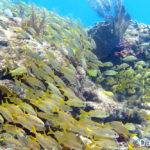
Imagine a school of white fish with brilliant yellow stripes hanging suspended in the water. They’re so tightly packed together that it appears at first to be a single organism. Pulsing like a heart, it is connected electrically through the water, small movements causing a gentle animation as the mass jolts, stops, starts again, and flows like its own river through a maze of living coral reef. Countless yellowtail snapper in inhabit the shallow reef off Key Largo in Florida Keys National Marine Sanctuary.
At Snapper Ledge, the reef surrounds divers as it rises up into a mound resembling an underwater island surrounded by sand. Above the sandy bottom, red, orange, and pink sponges and macroalgae cover mounds of calcium carbonate. Waving brown and yellow plumes of gorgonians and the purple and brown lace of sea fans move with the ebb and flow of the tide and currents. The serene scene is so mesmerizing that if you could stay at this depth forever and observe the life as it moves around you — you would.
USS Monitor, Monitor National Marine Sanctuary
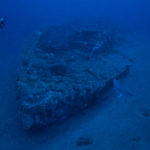
Complete with the world’s first rotating gun turret, low draft, and sleek profile, the ironclad USS Monitor heralded the end of the era of wooden warships. But on December 31, 1862, Monitor met its demise. Caught in a violent storm 16 miles off the coast of Cape Hatteras, Monitor sank as it was being towed. Of the 62 crew members, 46 were rescued, but 16 perished that fateful night. The wreck of Monitor was designated in 1975 as the first national marine sanctuary in the United States.
To dive Monitor today, you’ll need a free permit. You’ll also need the technical-diving experience to navigate strong currents and often adverse weather conditions in 230 feet (70 m) of water. Divers may encounter seasonal migrations of cetaceans, sea turtles, sharks, and manta rays near the wreck. Crabs, brittle stars, sea urchins, sea anemones, tube worms, oysters, and a host of other organisms blanket Monitor’s hull.
Mushroom Rock, Olympic Coast National Marine Sanctuary
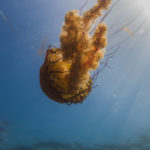
Marked by a mushroom-shaped rock along the Cape Flattery shoreline, this dive site in Olympic Coast National Marine Sanctuary offers advanced divers an interesting assortment of marine life and volcanic rock formations. Access is by boat and depths reach 70 to 80 feet (21 to 24 m). Boulders, walls, crevices and channels provide habitat for a variety of marine creatures. These include colonies of lightbulb ascidians, strawberry anemones, and red gorgonian corals. Divers report seeing numerous species of rockfish. Giant Pacific octopus, Puget Sound king crabs, and red-eyed jellyfish are also known to inhabit the area. With relatively mild currents for the area and good visibility, along with interesting scenery on the surface and below, Mushroom Rock rarely disappoints.
Middle Island Sinkhole, Thunder Bay National Marine Sanctuary
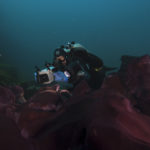
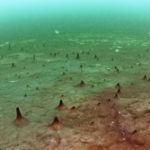
Divers from around the world travel to the Great Lakes for stellar wreck diving. Thunder Bay National Marine Sanctuary is a top destination. However, one dive site within the sanctuary offers divers a truly unique experience: the opportunity to travel billions of years back in time.
Situated off Middle Island, the so-called “Middle Island Sinkhole” is as unassuming as dive sites get. A sanctuary mooring buoy marks the site about 100 yards from the island’s shore. Descending this line, however, divers enter an otherworldly scene. At the base of the mooring is a giant crack in the lake’s limestone floor. Through this opening, cold, mineral-rich water gushes out and over a 20-foot-tall pile of enormous limestone boulders. As it crests this mound, it spills into a flat, circular depression in the lake bottom, 80 feet (24 m) from the surface. Light bends and shifts at the hazy interface between the swelling groundwater flow and the ambient lake water.
Coating the sinkhole’s bottom is a dense carpet of multicolored bacterial mats. Reminiscent of plush, velvet fabric, these microorganisms are woven into thick patches of red, white, and purple. They are the descendants of ancient species of cyanobacteria. More than 2 billion years ago, these tiny little cells were responsible for producing the oxygen that now makes up 21 percent of our atmosphere. Swimming through the haze of mixing water, across a vast field of ancient bacteria, divers are immersed in an ethereal realm where past and present intersect on the bottom of one of the world’s largest lakes.
By guest author Savanna Mahn, NOAA Office of National Marine Sanctuaries
Savanna Mahn is a certified scuba diver and volunteer communications intern at NOAA’s Office of National Marine Sanctuaries. Also contributing: John Bright, Thunder Bay National Marine Sanctuary and Brenda Altmeier, Florida Keys National Marine Sanctuary.
The post Ten Fantastic Dives in National Marine Sanctuaries appeared first on Scuba Diver Life.
from Scuba Diver Life https://ift.tt/2KNaSNq

 Look for last-minute rooms
Look for last-minute rooms Enjoy a home stay
Enjoy a home stay


